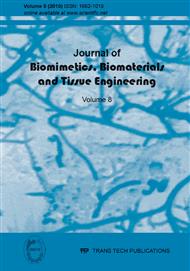[1]
T. V. Chirila, Y. -C. Chen, B. J. Griffin and I. J. Constable: Polym. Int. Vol. 32 (1993) p.221.
Google Scholar
[2]
Y. -C. Chen, T. V. Chirila and A. V. Russo: Mater. Forum Vol. 17 (1993) p.57.
Google Scholar
[3]
T. V. Chirila et al.: Biomaterials Vol. 14 (1993) p.26.
Google Scholar
[4]
T. V. Chirila, B. Higgins and P. D. Dalton: Cellular Polym. Vol. 17 (1998) p.141.
Google Scholar
[5]
Q. Liu et al.: Biomaterials Vol. 21 (2000) p.2163.
Google Scholar
[6]
I. Keen et al.: J. Biomimetics Biomater. Tissue Eng., Vol. 6 (2010) p.67.
Google Scholar
[7]
S. A. Rosenbluth, G. R. Weddington, W. L. Guess and J Autian: J. Pharm. Sci. Vol. 54 (1965), p.156.
Google Scholar
[8]
C. A. Homsy et al.: J. Biomed. Mater. Res. Vol. 3 (1969), p.235.
Google Scholar
[9]
C. A. Homsy et al.: J. Macromol. Sci. − Chem. Vol. A4 (1970) p.615.
Google Scholar
[10]
E. T. Oppenheimer, M. Willhite, I. Danishefsky and A. P. Stout: Cancer Res. Vol. 21 (1961) p.132.
Google Scholar
[11]
M. E. De Bakey et al.: Arch. Surg. Vol. 89 (1964) p.757.
Google Scholar
[12]
E. J. Kaminski, R. J. Oglesby, N. K. Wood and J. Sandrik: J. Biomed. Mater. Res. Vol. 2 (1968) p.81.
Google Scholar
[13]
J. M. Anderson and K. M. Miller: Biomaterials Vol. 5 (1984) p.5.
Google Scholar
[14]
R. V. Robinson, F. M. Sullivan, J. F. Borzelleca and S. L. Schwartz: PVP: A Critical Review of the Kinetics and Toxicology of Polyvinylpyrrolidone (Povidone), Lewis Publishers, Chelsea, MI (1990).
DOI: 10.1201/9780203741672
Google Scholar
[15]
R. Duncan et al.: Biochem. J. Vol. 196 (1981) p.49.
Google Scholar
[16]
R. Duncan, P. Rejmanová, J. Kopeček and J. B. Lloyd: Biochim. Biophys. Acta Vol. 678 (1981) p.143.
Google Scholar
[17]
R. Duncan et al.: Biochim. Biophys. Acta Vol. 799 (1984) p.1.
Google Scholar
[18]
L. A. McCormick, L. C. W. Seymour, R. Duncan and J. Kopeček: J. Bioact. Compat. Polym. Vol. 1 (1986) p.901.
Google Scholar
[19]
J. G. Shiah et al.: Eur. J. Cancer Vol. 37 (2001) p.131.
Google Scholar
[20]
J. Liu et al.: Mol. Pharmaceutics Vol. 6 (2009) p.959.
Google Scholar
[21]
J. Liu et al.: J. Controlled Rel. Vol. 143 (2010) p.71.
Google Scholar
[22]
J. Chiefari et al.: Macromolecules Vol. 31 (1998) p.5559.
Google Scholar
[23]
R. Plummer, Y. -K. Goh, A. K. Whittaker and M. J. Monteiro: Macromolecules Vol. 38 (2005) p.5352.
Google Scholar
[24]
L. Zhang et al.: Biomacromolecules Vol. 8 (2007) p.2890.
Google Scholar
[25]
M. H. Stenzel, C. Barner-Kowollik, T. P. Davis and H. M. Dalton: Macromol. Biosci. Vol. 4 (2004) p.445.
Google Scholar
[26]
M. Nakayama and T. Okano: Biomacromolecules Vol. 6 (2005) p.2320.
Google Scholar
[27]
J. Xu et al.: Macromolecules Vol. 39 (2006) p.8616.
Google Scholar
[28]
V. Lima et al.: J. Polym. Sci. A: Polym. Chem. Vol. 43 (2005) p.959.
Google Scholar
[29]
X. -P. Qiu and F. M. Winnik: Macromolecules Vol. 40 (2007) p.872.
Google Scholar
[30]
B. Chong et al.: Aust. J. Chem. Vol. 59 (2006) p.755.
Google Scholar
[31]
S. Perrier, P. Takolpuckdee and C. A. Mars: Macromolecules Vol. 38 (2005) p. (2033).
Google Scholar
[32]
Y. K. Chong, G. Moad, E. Rizzardo and S. H. Thang: Macromolecules Vol. 40 (2007) p.4446.
Google Scholar
[33]
S. Oae, T. Yagihara and T. Okabe: Tetrahedron Vol. 28 (1972) p.3203.
Google Scholar
[34]
C. Barner-Kowollik, P. Vana, J. F. Quinn and T. P. Davis: J. Polym. Sci. A: Polym. Chem. Vol. 40 (2002) p.1058.
Google Scholar
[35]
C. W. Scales, A. J. Covertine and C. L. McCormick: Biomacromolecules Vol. 7 (2006) p.1389.
Google Scholar
[36]
D. Horák, M. Červinka and V. Půža: Biomaterials Vol. 18 (1997) p.1355.
Google Scholar
[37]
L. Fornůsek, V. Větvička and J. Kopeček: Experientia Vol. 37 (1981) p.418.
Google Scholar
[38]
V. Větvička, L. Fornůsek, J. Kopeček and D. Přikrylová: Folia Biologica Vol. 29 (1983) p.424.
Google Scholar
[39]
A. J. Lentz, T. A. Horbett, L. Hsu and B. D. Ratner: J. Biomed. Mater. Res. Vol. 19 (1985) p.1101.
Google Scholar
[40]
K. Smetana, Jr. et al.: J. Biomed. Mater. Res. Vol. 24 (1990) p.463.
Google Scholar
[41]
K. Smetana, Jr. et al.: Clin. Mater. Vol. 13 (1993) p.47.
Google Scholar
[42]
B. W. Ziegelaar et al.: J. Biomater. Sci. Polym. Edn Vol. 9 (1998) p.849.
Google Scholar
[43]
G. Mabilleau et al.: Biomaterials Vol. 25 (2004) p.5155.
Google Scholar


